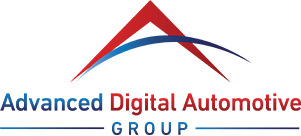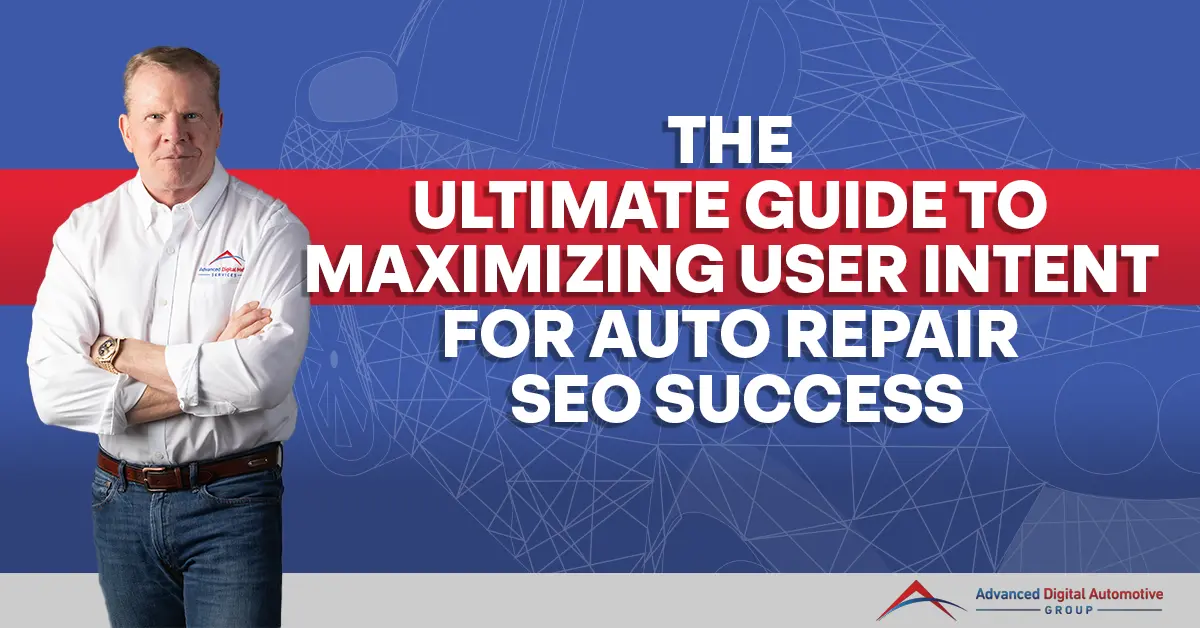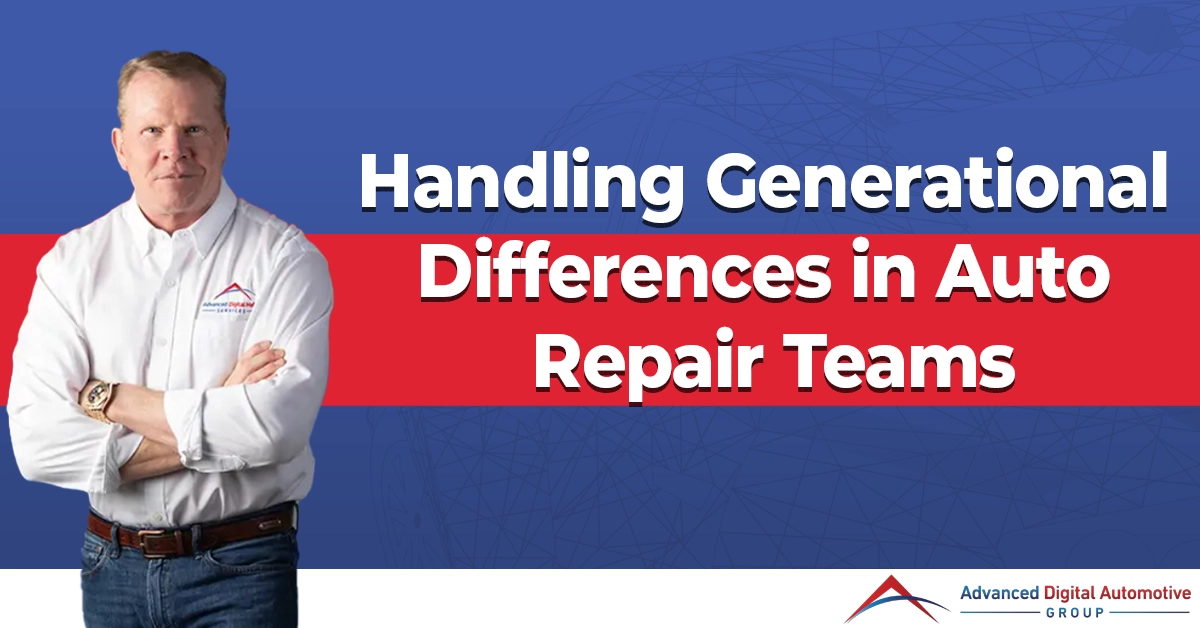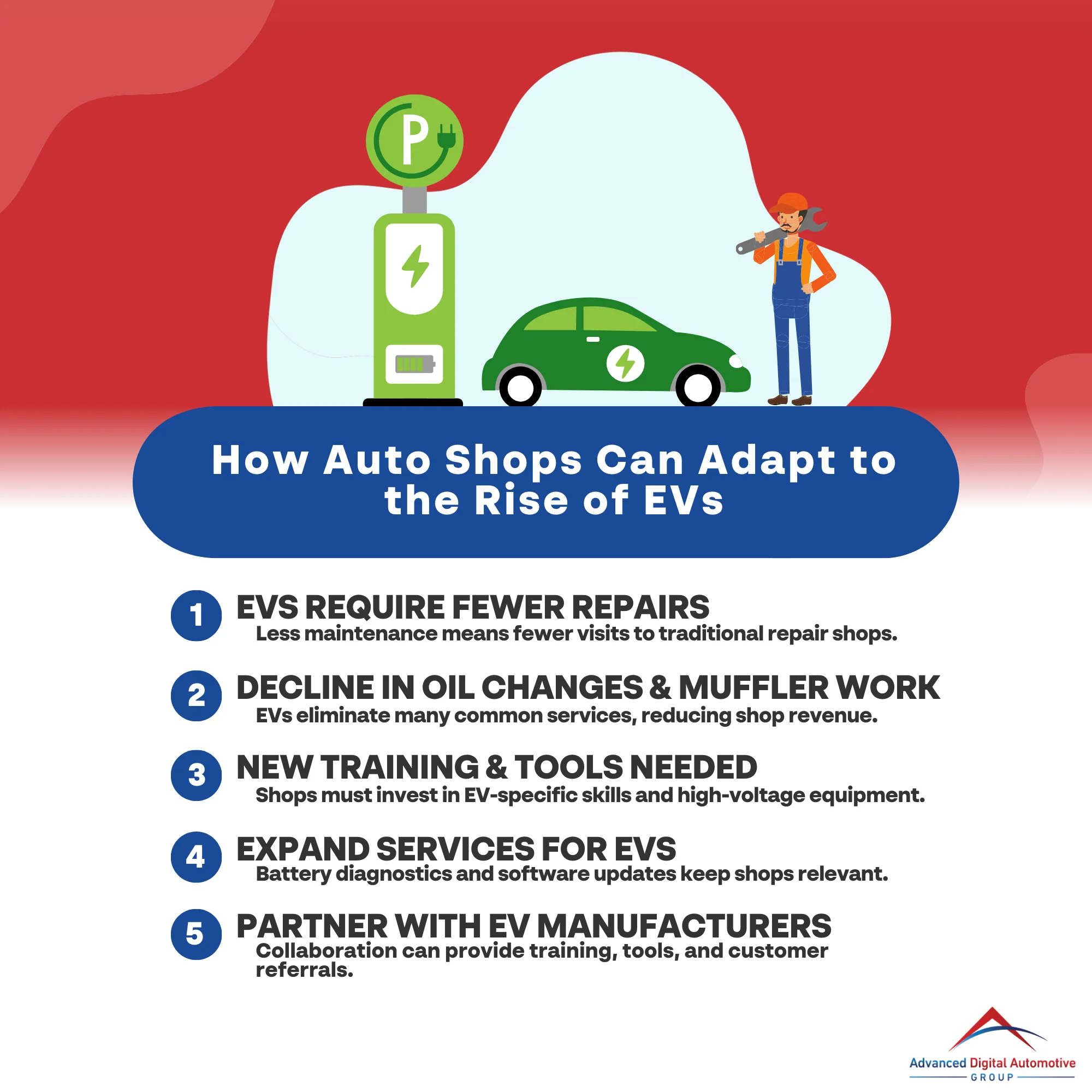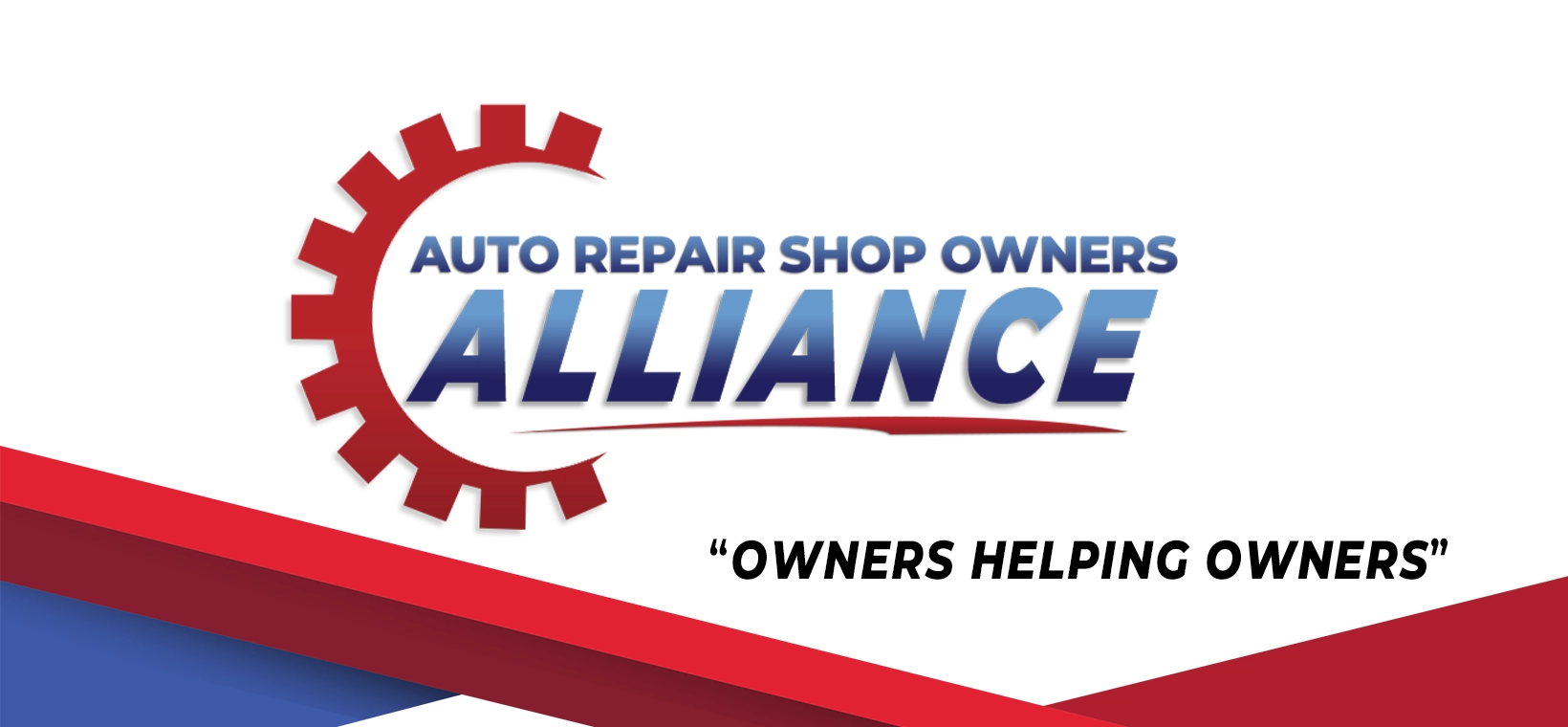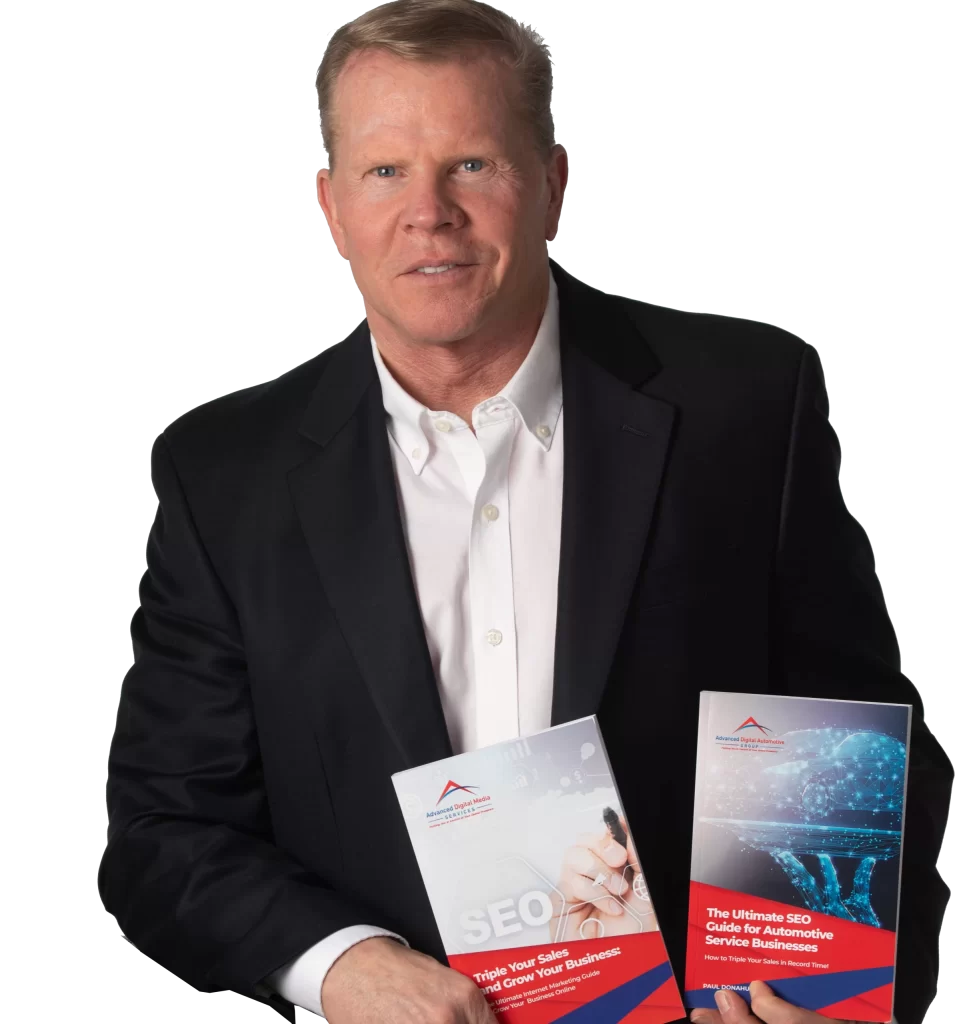To maximize user intent for your auto repair SEO success, start by understanding the three types of intent: informational, navigational, and transactional. Use tools like Google Keyword Planner to align keyword research with these intents. Optimize your landing pages to address specific user needs and craft clear CTAs that encourage action. Also, focus on local optimization by including geo-specific keywords and ensuring your Google Business Profile is accurate. Monitor bounce rates to refine your content strategy. By analyzing these factors, you’re setting the stage for increased engagement and conversion. More insights await to elevate your SEO game.
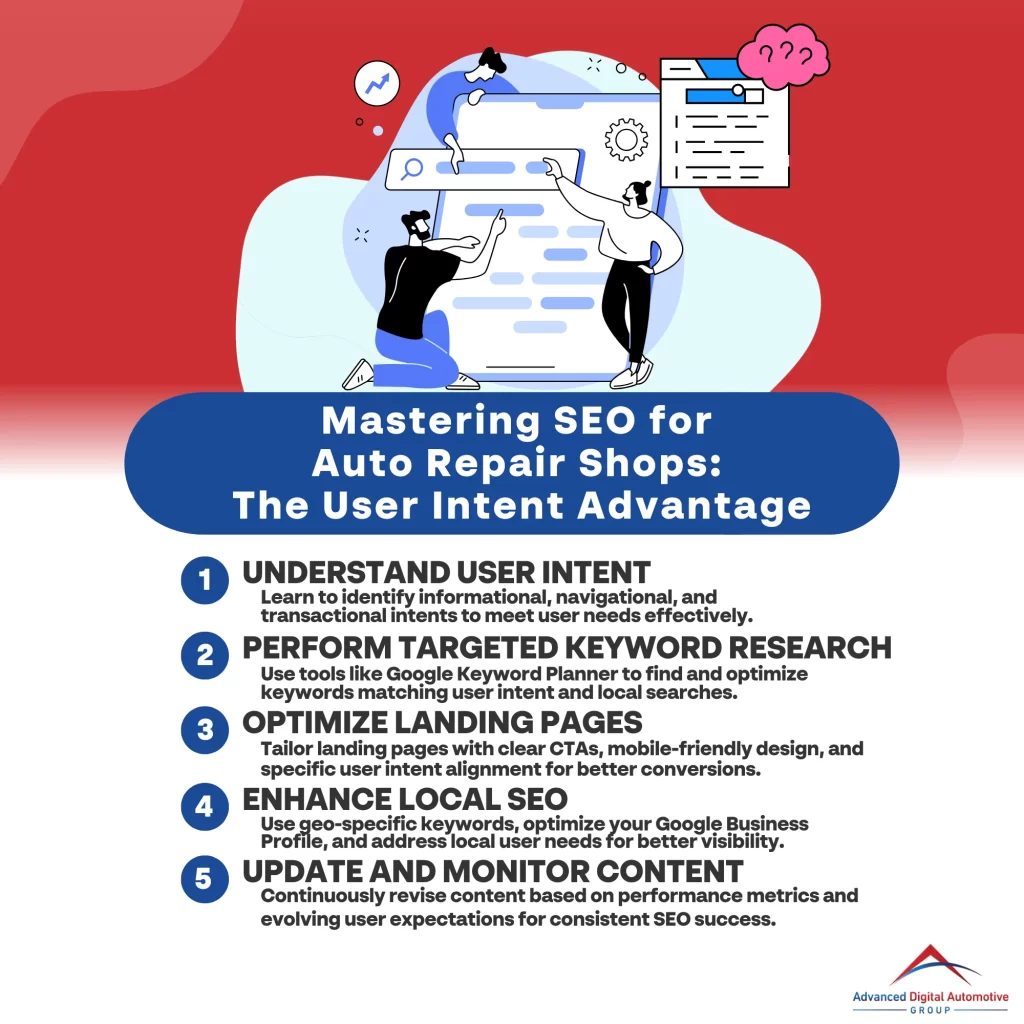
Key Takeaways
- Analyze user intent by categorizing searches into informational, navigational, and transactional to create relevant content for auto repair services.
- Conduct keyword research focused on local terms like “auto repair in [your city]” to enhance visibility and attract nearby customers.
- Utilize diverse content formats, including blogs and videos, to engage different user preferences and improve interaction rates.
- Optimize landing pages with clear headers, concise content, and strong visuals that align with user intent and improve mobile usability.
- Monitor performance metrics, such as bounce rates, to adjust content and ensure alignment with user expectations for continuous improvement.
Understand the Types of User Intent (Informational, Navigational, Transactional)
Understanding user intent is a key component in optimizing your auto repair shop’s SEO strategy. User intent refers to the reason behind a user’s search query, and it primarily falls into three categories: informational, navigational, and transactional.
Informational intent involves users seeking knowledge or answers, like “how to change a tire” or “what causes engine noise.” For your shop, creating blog posts or guides addressing common automotive issues can cater to this intent and drive organic traffic.
Navigational intent occurs when users look for a specific website or service, such as searching for your shop’s name. Optimizing your Google Business Profile and maintaining a clear, easy-to-navigate website can help guarantee they find you quickly.
Transactional intent indicates users ready to make a purchase or book a service, often reflected in searches like “auto repair near me” or “oil change appointment.” Reinforcing your site with clear calls to action and easy booking options can remarkably boost conversion rates.
Perform Keyword Research Aligned with User Intent
Performing keyword research aligned with user intent is vital for maximizing your auto repair shop’s online visibility. Start by identifying the specific needs and motivations of your target audience. Use tools like Google Keyword Planner and SEMrush to gather data on relevant search terms.
Focus on keywords that reflect various types of user intent for SEO, such as informational, navigational, and transactional queries. Analyze search volume and competition levels for each keyword to prioritize your efforts. For instance, if potential customers frequently search for “emergency car repair near me,” this indicates a high intent to book services immediately.
On the other hand, terms like “how to maintain my car” cater to informational intent and can establish your authority in the industry. Don’t forget to take into account local intent, as most customers seek auto repair services nearby. Incorporate local keywords, like “auto repair in [your city],” to strengthen your visibility in local searches.
Optimize Landing Pages for Specific Intent
Optimizing landing pages for specific intent directly complements your keyword research efforts. When you align your landing pages with user intent in SEO, you create a seamless experience that meets the needs of potential customers.
Start by categorizing user intent into three main types: informational, navigational, and transactional. Tailor each landing page to address these intents effectively.
For instance, if a user searches for “oil change near me,” guarantee your landing page highlights your oil change services, includes relevant details like pricing and location, and showcases positive reviews.
Utilize clear headers and concise content to improve readability, making it easy for users to find the information they seek. Incorporate keywords naturally, as they guide search engines in understanding the page’s focus.
Employ strong visuals and engaging content to keep visitors on the page longer, which can boost your SEO rankings.
Don’t forget to optimize for mobile users, as many searchers will be on their phones. By aligning your landing pages with specific user intents, you maximize the chances of converting visitors into loyal customers, ultimately driving your auto repair shop’s success.
Create Clear and Compelling Call-to-Actions (CTAs)
To drive conversions effectively, creating clear and compelling call-to-actions (CTAs) is crucial for your auto repair shop’s website. CTAs guide your visitors toward the next steps, aligning with user intent SEO to improve engagement and conversion rates.
Here are four key elements to contemplate when crafting your CTAs:
- Clarity: Use straightforward language that leaves no room for confusion. Phrases like “Schedule Your Appointment” are direct and actionable.
- Visibility: Position your CTAs prominently on your site. Use contrasting colors or larger fonts to guarantee they stand out.
- Urgency: Incorporate time-sensitive language, such as “Limited Time Offer” or “Book Now to Save,” to encourage immediate action.
- Relevance: Tailor your CTAs to match the specific intent of users. For instance, if a visitor is looking for brake repair, a CTA like “Get a Free Brake Inspection” is more likely to resonate.
Provide Detailed and Relevant Content to Address Questions
Clear and compelling calls-to-action are just one part of a thorough strategy for engaging potential customers. To truly resonate, you need to provide detailed and relevant content that addresses user questions.
Conducting a user intent analysis helps you understand what potential customers are searching for, enabling you to create content that directly answers their queries.
For instance, if users are looking for information on brake repair, your content shouldn’t only explain the signs of brake wear but also detail the repair process, costs, and why your shop is the best choice. This approach not only attracts traffic but also builds trust.
Also consider using various formats like blogs, FAQs, and videos to cater to different learning preferences. Research shows that informative content can increase engagement and conversion rates considerably.
Use Schema Markup to Enhance Search Visibility
A strategic implementation of schema markup can significantly increase your auto repair shop’s search visibility. By using structured data, you can help search engines understand your content better, aligning it with user intent, and improving your rankings.
Here’s how schema markup can benefit your business:
- Improved Rich Snippets: Schema markup can help your listings stand out with rich snippets, such as customer reviews and service details, increasing click-through rates.
- Enhanced Local SEO: It enables search engines to display relevant local information, making it easier for nearby customers to find your shop.
- Better Contextual Understanding: By clarifying the services you offer, schema markup helps search engines match your content with search queries that reflect user intent.
- Increased Trustworthiness: Search engines view sites with schema markup as more credible, which can positively influence user perception and engagement.
Incorporating schema markup isn’t just about improving search visibility; it’s a critical step in addressing user intent directly.
Analyze Search Queries to Adjust Content Strategy
Understanding search queries is integral to refining your content strategy and aligning it with user intent. By analyzing these queries, you can identify what potential customers are looking for and tailor your content accordingly.
Start by using tools like Google Search Console or keyword research platforms to uncover high-traffic keywords related to auto repair services. This data reveals popular queries and the intent behind them, enabling you to create relevant content.
Focus on different types of seo user intent—informational, navigational, and transactional. Each type signals a specific need. For instance, someone searching for “how to change brake pads” demonstrates informational intent, while “brake repair near me” indicates a readiness to book a service.
By addressing these intents in your content, you’re more likely to attract the right audience.
Regularly revisiting and adjusting your content based on search query analysis helps maintain relevance and boosts your SEO performance. As user behavior shifts, so should your strategy.
Stay data-driven, and you’ll amplify your ability to connect with potential customers effectively, leading to increased engagement and conversions.
Optimize for Local Intent with Geo-Specific Keywords
Local intent plays a pivotal role in driving foot traffic and increasing conversion rates for auto repair shops. To optimize for this intent, you need to incorporate geo-specific keywords that resonate with your target audience.
Here’s how you can maximize utility:
- Identify Key Locations: Research neighborhoods, cities, or regions where your potential customers reside. Use tools like Google Trends to understand popular local queries.
- Incorporate Local Keywords: Use phrases like “auto repair in [Your City]” or “car service near [Neighborhood]” throughout your website content. This boosts your visibility in local searches.
- Optimize Google Business Profile: Confirm your profile includes your address, phone number, and services. Regularly update it with posts, photos, and customer reviews to increase engagement.
- Create Location-Specific Content: Develop blog posts or service pages that address local issues, such as weather-related repairs or local events that may impact vehicle maintenance.
Monitor Bounce Rates to Identify Mismatched Intent
Monitoring bounce rates provides valuable insights into user intent and can highlight areas where your content may not align with what visitors expect. A high bounce rate often indicates that users aren’t finding what they’re looking for, signaling a mismatch in intent.
For instance, if potential customers search for “quick oil change prices” but land on a page detailing in-depth engine repairs, it’s no surprise they leave immediately. This disconnect can hurt your SEO efforts.
To better understand user intent examples, analyze your content’s performance. Segment your data by traffic source, landing pages, and user demographics. This helps you pinpoint which specific pages are underperforming and why.
Are your keywords effectively addressing user queries? Are your titles and meta descriptions accurately representing the content?
Once you identify these mismatches, adjust your content accordingly. Rewrite headlines, optimize for relevant keywords, and guarantee the information meets user expectations.
Continuously Update Content to Reflect Evolving User Needs
Your website’s content should be a living entity, constantly evolving to meet the changing needs of users. To maximize utility definition in your auto repair SEO strategy, you need to stay ahead of trends and adapt your content accordingly.
Here are four critical steps to guide your updates:
- Monitor User Behavior: Analyze metrics like page views and time spent on pages to identify what users find valuable.
- Solicit Feedback: Engage with customers through surveys or reviews to understand their evolving preferences and pain points.
- Update Keywords: Regularly research and incorporate trending keywords related to auto repair to boost search visibility.
- Refresh Content: Revise existing articles and blogs with new information, visuals, or tips to keep them relevant and informative.
Frequently Asked Questions
How Do I Measure the Success of My SEO Efforts?
To measure your SEO success, track key metrics like organic traffic, conversion rates, and keyword rankings. Use tools like Google Analytics to analyze data and adjust your strategies based on performance trends and user behavior.
What Are the Common Mistakes in Auto Repair SEO?
Common mistakes in auto repair SEO include neglecting local optimization, failing to manage online reviews, and ignoring keyword research, which can hurt your visibility and engagement.
How Often Should I Update My Website Content?
You should update your website content regularly, ideally every few months. Fresh, relevant content improves search rankings and keeps visitors engaged. Consistent updates also signal to search engines that your site remains active and valuable.
Can Social Media Impact My SEO Rankings?
Yes, social media can impact your SEO rankings. Engaging content drives traffic, increases brand visibility, and encourages backlinks. This interaction signals relevance to search engines, boosting your overall online presence and authority.
What Tools Can Help Me With SEO Analysis?
To upgrade your SEO analysis, use tools like Google Analytics for traffic insights, SEMrush for keyword tracking, and Ahrefs for backlink analysis. These tools help you make data-driven decisions, improving your overall online visibility.
Conclusion
By understanding and maximizing user intent, you can considerably boost your auto repair shop’s online visibility and customer engagement. For instance, a hypothetical auto repair shop that optimized its landing pages for specific transactional keywords saw a 40% increase in appointment bookings within three months. This example highlights the importance of aligning your content strategy with user intent to drive conversions. Stay proactive in refining your approach, and watch your business thrive in a competitive landscape.
